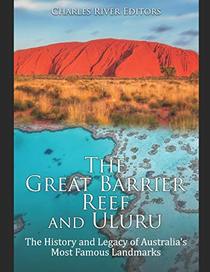This is an overview of two of the most fascinating natural occurrences in Australia. They have been combined in one book even though they are separated by thousands of miles in Australia. Uluru is nearly in the center of the country while the Great Barrier Reef is along Australia's northeast coastline.
ULURU -- Rating = E
Today, I learned that Uluru is a monolith, an inselberg, or more specifically, an island mountain. Another way of describing it is to say that it is a small mountain that rises abruptly from a gently sloping or virtually level surrounding plain. I wasn't aware of the term but it fits Ayer's Rock perfectly. It is 1142 feet tall with a girth of about 6 miles wide. Much of Uluru's torso is buried underground. It is about a 6-hour drive to the closest town (Alice Springs).
There's an explanation of the history of the indigenous peoples who viewed the formation as sacred and even theories of how the great Ayers Rock was formed. Then there is the unfortunate history of the government vs. the indigenous peoples for control of the area.
Our family was in the country while Lindy Chamberlain's story of the loss of her 9-week-old baby was just about the only discussion in the country. Everyone in Australia had an opinion and it was still the main topic of conversation (it happened in 1980 and we were there in 1982). It took 32 years for a coroner to determine that baby Azaria could have been lifted and carried off by dingos. This was the most important news for a decade; I'm delighted the Charles Rivers included this incident because of its importance.
THE GREAT BARRIER REEF -- Rating of photos = E; Rating of text = G
The photos shown in this section were outstanding; the text was not very good. The authors, in a search for authenticity, gave vast passages of Capt. Cook and various other explorers and naturalists' works. They were boring and fairly uninteresting. Why the authors gave the 1975 Act to save the Great Barrier Reef (in full), instead of paraphrasing it, is beyond me. I'm amazed the author(s) could turn such a fascinating subject into a bore.
ULURU -- Rating = E
Today, I learned that Uluru is a monolith, an inselberg, or more specifically, an island mountain. Another way of describing it is to say that it is a small mountain that rises abruptly from a gently sloping or virtually level surrounding plain. I wasn't aware of the term but it fits Ayer's Rock perfectly. It is 1142 feet tall with a girth of about 6 miles wide. Much of Uluru's torso is buried underground. It is about a 6-hour drive to the closest town (Alice Springs).
There's an explanation of the history of the indigenous peoples who viewed the formation as sacred and even theories of how the great Ayers Rock was formed. Then there is the unfortunate history of the government vs. the indigenous peoples for control of the area.
Our family was in the country while Lindy Chamberlain's story of the loss of her 9-week-old baby was just about the only discussion in the country. Everyone in Australia had an opinion and it was still the main topic of conversation (it happened in 1980 and we were there in 1982). It took 32 years for a coroner to determine that baby Azaria could have been lifted and carried off by dingos. This was the most important news for a decade; I'm delighted the Charles Rivers included this incident because of its importance.
THE GREAT BARRIER REEF -- Rating of photos = E; Rating of text = G
The photos shown in this section were outstanding; the text was not very good. The authors, in a search for authenticity, gave vast passages of Capt. Cook and various other explorers and naturalists' works. They were boring and fairly uninteresting. Why the authors gave the 1975 Act to save the Great Barrier Reef (in full), instead of paraphrasing it, is beyond me. I'm amazed the author(s) could turn such a fascinating subject into a bore.




